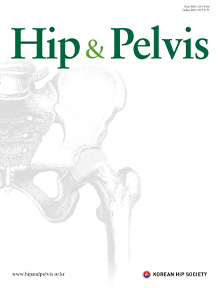Original Article
J Korean Hip Soc 2008; 20(1): 27-34
Published online March 1, 2008
© The Korean Hip Society
감염성 인공 고관절의 치료
이중명∙남희태
국립의료원 정형외과
Treatment of Infected Total Hip Arthroplasty
Correspondence to : 이중명
서울특별시 중구 을지로6가 18-79 국립의료원 정형외과
TEL: 82-2-2260-7190
FAX: 82-2-2278-9570
E-mail: drjmlee@paran.com
Purpose: To analyze the effectiveness of a two-stage revision surgery for an infected total hip arthroplasty.
Materials and Methods: Between 1988 and 2005, twenty-four patients (24 hips, 18 males, 6 females) with documented infection of total hip arthroplasty were reviewed and followed for at least two years postoperatively. The preoperative and postoperative clinical and radiologic findings and blood laboratory work were compared. Eight arthroplasty cases were performed through retention of the femoral stem and removal of the acetabular cup with cementing by impregnated antibiotics in the first stage of the operation, and subsequent acetabular cup revision in the second stage of the operation.
Results: After the first stage of the operation, infectious organisms were cultured in 19 patients, and isolated Staphylococcus aureus was cultured in 14 patients. The mean follow-up period was 8.2 years, and the average Harris hip score improved to 88.4 points at last follow-up. Radiologic osteolysis was noted in 5 cases, and possible loosening was demonstrated in 1 case. The erythrocyte sediment rate (mm/hr) and C-reactive protein (mg/L) were 43.8/14.2 preoperatively and 17.9/8.3 postoperatively. There were 2 recurrences of infection, for an eradication rate of 91.7% (22 of 24).
Conclusion: Two-stage revision for an infected total hip arthroplasty proved to be an excellent method with a high eradication rate.
Keywords Infection, Total hip arthroplasty, Acetabular antibiotic impregnated cementing, Two-stage revision
Article
Original Article
J Korean Hip Soc 2008; 20(1): 27-34
Published online March 1, 2008 https://doi.org/10.5371/jkhs.2008.20.1.27
Copyright © The Korean Hip Society.
감염성 인공 고관절의 치료
이중명∙남희태
국립의료원 정형외과
Treatment of Infected Total Hip Arthroplasty
Joong-Myung Lee, M.D., Hee-Tae Nam, M.D.
Department of Orthopedic Surgery, National Medical Center, Seoul, Korea
Correspondence to:이중명
서울특별시 중구 을지로6가 18-79 국립의료원 정형외과
TEL: 82-2-2260-7190
FAX: 82-2-2278-9570
E-mail: drjmlee@paran.com
Abstract
Purpose: To analyze the effectiveness of a two-stage revision surgery for an infected total hip arthroplasty.
Materials and Methods: Between 1988 and 2005, twenty-four patients (24 hips, 18 males, 6 females) with documented infection of total hip arthroplasty were reviewed and followed for at least two years postoperatively. The preoperative and postoperative clinical and radiologic findings and blood laboratory work were compared. Eight arthroplasty cases were performed through retention of the femoral stem and removal of the acetabular cup with cementing by impregnated antibiotics in the first stage of the operation, and subsequent acetabular cup revision in the second stage of the operation.
Results: After the first stage of the operation, infectious organisms were cultured in 19 patients, and isolated Staphylococcus aureus was cultured in 14 patients. The mean follow-up period was 8.2 years, and the average Harris hip score improved to 88.4 points at last follow-up. Radiologic osteolysis was noted in 5 cases, and possible loosening was demonstrated in 1 case. The erythrocyte sediment rate (mm/hr) and C-reactive protein (mg/L) were 43.8/14.2 preoperatively and 17.9/8.3 postoperatively. There were 2 recurrences of infection, for an eradication rate of 91.7% (22 of 24).
Conclusion: Two-stage revision for an infected total hip arthroplasty proved to be an excellent method with a high eradication rate.
Keywords: Infection, Total hip arthroplasty, Acetabular antibiotic impregnated cementing, Two-stage revision

Article Tools
Stats or Metrics
Related articles in H&P
-
Trochanteroplasty for the Treatment of Uncontrolled Infected Total Hip Arthroplasty - A Case Report -
Kyung Soon Park, MD, Taek Rim Yoon, MD, Jae Young Moon, MD, Qin Sheng Hu, MD
J Korean Hip Soc 2011; 23(3): 221-224 -
Treatment of Infected Total Hip Arthroplasty
Han-Seok Ko, MD, Woo-Han Bae, MD
J Korean Hip Soc 2010; 22(2): 104-110 -
Stenotrophomonas maltophilia Periprosthetic Joint Infection after Hip Revision Arthroplasty
Valentino Latallade, MD, Carlos Lucero, MD, Pablo Slullitel, MD, Martin Buttaro, MD
Hip Pelvis 2023; 35(2): 142-146




 PDF
PDF Standard view
Standard view Export citation
Export citation Share
Share  Previous Article
Previous Article



